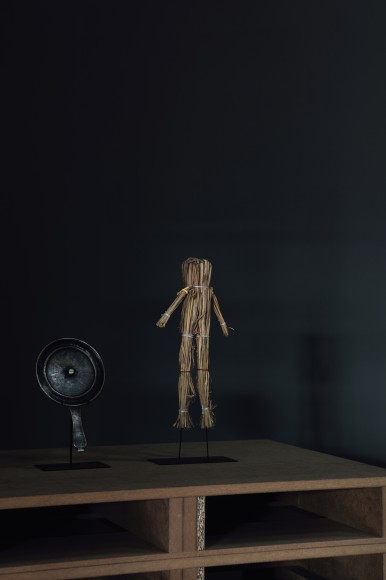|

SPEAKING IN THE VOICES OF DIFFERENT GODS
As Stidworthy��s installation shows us, Korea��s hyper-modernity is deeply infused with archaic traits – a condition that is as fascinating as it is scary – and the ambiguous figure of the shaman holds the key to these characteristics. There are over 800,000 officially registered shamans in Korea; most of them are women.Speaking in the Voices of Different Gods consists of three projections and various objects. Two of the video sequences show female shamans, while the third – a 3D scan – explores two shamanistic objects, a mirror and a straw idol, from the inside out. These objects are also present as physical objects.The shaman from Gimhae (she renounced her name after initiation) was filmed during two divinations. In them, we hear her speaking mainly as a baby girl god with a cute, child-like vocabulary, or (towards the end of the sequence) as an angry and scornful grandfather god. The images were recorded in a ��shaman��s district��, which is a relatively new phenomenon in Korea. Traditionally, shamans were supposed to live apart so that their respective gods would not become jealous of each other.
Stidworthy asked Soon Deok, the other shaman, to recall a Salpuri she had danced at Seoul National University in 1986. It had been done to appease the tormented soul of Park Jong Chul, a student who had been tortured to death at the hands of the police. Soon Deok��s on-screen narrative blends politics with her experience of aphasia (the loss of speech) and personal renewal.The one experience that both shamans share is that of having several voices. They also assume different roles – a capacity that probably stems from women��s historical obligation to fulfill different, often conflicting roles under patriarchal rule, despite the very limited social space afforded them.The 3D scans appear to explore the inner life of animated objects: the mirror that reflects not the visible world, but the invisible energy of the shaman and the idol onto which the shaman transfers the disease that has befallen a human body. Here, too, the archaic mingles with the hyper-modern. The technological journey through the object��s interior is not at all real, as the 3D imagery suggests. The scan merely extrapolates data gleaned from the object��s surface.
|